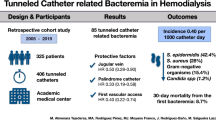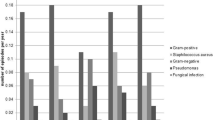Abstract
Purpose
Over-the-wire exchange of tunneled dialysis catheters is the standard of care per K/DOQI guidelines for treating catheter-related bacteremia. However, Gram-positive bacteremia, specifically with staphylococcus species, may compromise over-the-wire exchange due to certain biological properties. This study addressed the effectiveness of over-the-wire exchange of staphylococcus-infected tunneled dialysis catheters compared with non-staphylococcus-infected tunneled dialysis catheters.
Methods
Patients who received over-the-wire exchange of their tunneled dialysis catheter due to documented or suspected bacteremia were identified from a QA database. Study patients (n = 61) had positive cultures for Staphylococcus aureus, Staphylococcus epidermidis, or coagulase-negative staphylococcus not otherwise specified. Control patients (n = 35) received over-the-wire exchange of their tunneled dialysis catheter due to infection with any organism besides staphylococcus. Overall catheter survival and catheter survival among staphylococcal species were assessed.
Results
There was no difference in tunneled dialysis catheter survival between study and control groups (P = 0.46). Median survival time was 96 days for study catheters and 51 days for controls; survival curves were closely superimposed. There also was no difference among the three staphylococcal groups in terms of catheter survival (P = 0.31). The median time until catheter removal was 143 days for SE, 67 days for CNS, and 88 days for SA-infected catheters.
Conclusions
There is no significant difference in tunneled dialysis catheter survival between over-the-wire exchange of staphylococcus-infected tunneled dialysis catheters and those infected with other organisms.



Similar content being viewed by others
References
Trerotola SO, Johnson MS, Harris VJ et al (1997) Outcome of tunneled hemodialysis catheters placed via the right internal jugular vein by interventional radiologists. Radiology 203:489–495
Marr KA, Sexton DJ, Conlon PJ, Corey GR, Schwab SJ, Kirkland KB (1997) Catheter-related bacteremia and outcome of attempted catheter salvage in patients undergoing hemodialysis. Ann Intern Med 127:275–280
Beathard GA (1999) Management of bacteremia associated with tunneled-cuffed hemodialysis catheters. J Am Soc Nephrol 10:1045–1049
Tanriover B, Carlton D, Saddekni S et al (2000) Bacteremia associated with tunneled dialysis catheters: comparison of two treatment strategies. Kidney Int 57:2151–2155
Mokrzycki MH, Zhang M, Cohen H, Golestaneh L, Laut JM, Rosenberg SO (2006) Tunnelled haemodialysis catheter bacteraemia: risk factors for bacteraemia recurrence, infectious complications and mortality. Nephrol Dial Transplant 21:1024–1031
Saad TF (1999) Bacteremia associated with tunneled, cuffed hemodialysis catheters. Am J Kidney Dis 34:1114–1124
Foundation NK (2006) Clinical practice guidelines for vascular access. Am J Kidney Dis 48(Suppl 1):S176–S247
Saad TF, Vesely TM (2004) Venous access for patients with chronic kidney disease. J Vasc Interv Radiol 15:1041–1045
Beathard GA, Urbanes A (2008) Infection associated with tunneled hemodialysis catheters. Semin Dial 21:528–538
Cooper ET, Cohen RM, Berns JS, Kornfield ZN, Trerotola SO (2007) Impact of tip culture on the management of infected tunneled hemodialysis catheters. J Vasc Interv Radiol 18:1227–1231
Maki DG, Weise CE, Sarafin HW (1977) A semiquantitative culture method for identifying intravenous-catheter-related infection. N Engl J Med 296:1305–1309
Kohli MD, Trerotola SO, Namyslowski J et al (2001) Outcome of polyester cuff retention following traction removal of tunneled central venous catheters. Radiology 219:651–654
Patel A, Hofkin S, Ball D, Cohen G, Smith DC (2001) Sheathless technique of ash split-cath insertion. J Vasc Interv Radiol 12:376–378
Silberzweig JE, Sacks D, Khorsandi AS, Bakal CW (2003) Reporting standards for central venous access. J Vasc Interv Radiol 14:S443–S452
Allison P (1995) Survival analysis using the SAS system: a practical guide. SAS Institute Inc, Cary, NC
Cox D, Snell EJ (1984) Analysis of survival data. Chapman & Hall, London
Mermel LA, Allon M, Bouza E et al (2009) Clinical practice guidelines for the diagnosis and management of intravascular catheter-related infection: 2009 update by the infectious diseases society of America. Clin Infect Dis 49:1–45
Alomari AI, Falk A (2007) The natural history of tunneled hemodialysis catheters removed or exchanged: a single-institution experience. J Vasc Interv Radiol 18:227–235
Acknowledgement
Supported in part by: NIDDK, 2008, T35 DK 060441-06 NIDDK Short Term Experience in Research Grant.
Conflict of interest
Dr. Trerotola is a consultant for MedComp, Bard, Arrow, and Cook. None of the other authors has a conflict to disclose.
Author information
Authors and Affiliations
Corresponding author
Rights and permissions
About this article
Cite this article
Langer, J.M., Cohen, R.M., Berns, J.S. et al. Staphylococcus-Infected Tunneled Dialysis Catheters: Is Over-the-Wire Exchange an Appropriate Management Option?. Cardiovasc Intervent Radiol 34, 1230–1235 (2011). https://doi.org/10.1007/s00270-011-0180-4
Received:
Accepted:
Published:
Issue Date:
DOI: https://doi.org/10.1007/s00270-011-0180-4




